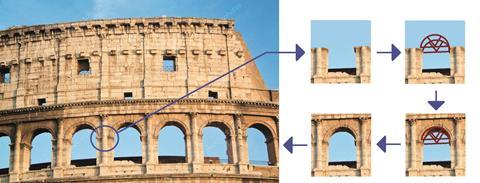We asked readers what buildings were futuristic in their time, or marked a change in how the industry built. Here, Jason Langer answers the question: what have the Romans ever done for us?

We don’t always have to look to the future to develop new and better ways of designing and constructing buildings; some great innovations lie deep in the past, and should still provide inspiration for us today.
We often say to our clients: “The best temporary works are permanent works.” This mantra underlines a desire to combine efficient structural systems with detailing that makes them simple and cost-effective to construct. Designing nirvana itself can be achieved if the buildable structural solution can be incorporated elegantly into the architectural concept. But how often does this actually happen?

The truth is – the Romans were achieving it millennia ago. When next you look at classic structural forms such as the Colosseum in Rome, look closely at the little shelf detail at the base of every archway. It has been copied as an architectural detail a million times over since – in houses, churches, assembly halls, train stations, everywhere. Some might think it is there simply as an architectural relief detail to express where the structure transitions from vertical to arch form.
In reality, it is a built-in piece of temporary works, designed to support the incomplete arch above, until the keystone is installed. That’s right - one of the most copied pieces of architectural detailing in the world, is a piece of temporary works engineering.
It is possible to develop design solutions that are entirely driven by construction methodology. We shouldn’t hide from this challenge – we should embrace it and look to make tomorrow’s history.
Postscript
Jason Langer is director at Robert Bird Group



























No comments yet